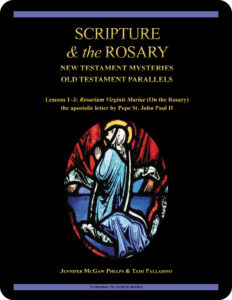 Scripture & the Rosary:
Scripture & the Rosary:
New Testament Mysteries,
Old Testament Parallels
The Creed
Lesson 5 God’s Only Son: Redemption & Hope
the Letter to the Hebrews 6:13–20
the book of Genesis 24:58–60
the book of Genesis 24:62–67
Revised Standard Version Catholic Edition (RSVCE)*
New American Bible Revised Edition (NABRE)*
Catechism of the Catholic Church
Rosarium Virginis Mariae (Rosary of the VIrgin Mary)
ex libris (in our library)
cross references for Scripture & the Rosary
next lesson: The Holy Spirit: Sanctification & Love
This material coordinates with Lesson 5 on pages 16–19 in Scripture & the Rosary: New Testament Mysteries, Old Testament Parallels.
And Mary said, “My soul magnifies the Lord, and my spirit rejoices in God my Savior,
for he has regarded the low estate of his handmaiden.
For behold, henceforth all generations will call me blessed;
for he who is mighty has done great things for me, and holy is his name.”
—the Gospel According to Luke 1:46–49
welcome to our in-depth study of Scripture & the Rosary
We invite groups and individuals to become acquainted with Turning to God’s Word Catholic Bible  studies through
studies through  Scripture & the Rosary: New Testament Mysteries, Old Testament Parallels, which has been granted an imprimatur. Although no longer available in print, the first six lessons can be downloaded from our website. The remaining 20 lessons are posted throughout the liturgical year along with their related online study pages. Click here to access Lesson 4 through Lesson 6. If you have a Bible-study question or comment, you can contact our authors any time by using one of the “ask us your question” or “what do you think” buttons on any online study page.
Scripture & the Rosary: New Testament Mysteries, Old Testament Parallels, which has been granted an imprimatur. Although no longer available in print, the first six lessons can be downloaded from our website. The remaining 20 lessons are posted throughout the liturgical year along with their related online study pages. Click here to access Lesson 4 through Lesson 6. If you have a Bible-study question or comment, you can contact our authors any time by using one of the “ask us your question” or “what do you think” buttons on any online study page.
open with prayer
It’s always wise to begin any Bible study with prayer, whether reading the Scriptures alone or meeting with others in a discussion group. You can pray using your own words or use one of the opening prayers on our website. We especially like the following:
Lord Jesus, you promised to send your Holy Spirit to teach us all things.
As we read and study your word today,
allow it to touch our hearts and change our lives. Amen.
Jesus isn’t a Motherless child
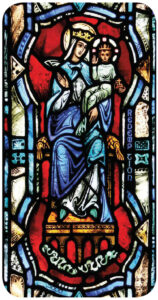 In the stained glass window that inspired Lesson 5—”God’s Only Son: Redemption and Hope”—the visual emphasis somewhat surprisingly appears to be on the Blessed Virgin Mary in the primary panel, and on Isaac’s intended wife Rebekah in the secondary panel. This suggests that it’s important for Christians to place a high value on motherhood. Clicking on the New and Old
In the stained glass window that inspired Lesson 5—”God’s Only Son: Redemption and Hope”—the visual emphasis somewhat surprisingly appears to be on the Blessed Virgin Mary in the primary panel, and on Isaac’s intended wife Rebekah in the secondary panel. This suggests that it’s important for Christians to place a high value on motherhood. Clicking on the New and Old  Testament stained glass window art will enlarge it. The same art also illustrates Lesson 5 in Scripture & the Rosary: New Testament Mysteries, Old Testament Parallels. You can learn more about the life of the patriarch Isaac and the beginning of his relationship with Rebekah in Lesson 12 The Birth of Isaac through Lesson 14 Isaac & Rebekah in the Turning to God’s Word Catholic Bible study In the Beginning: The Book of Genesis.
Testament stained glass window art will enlarge it. The same art also illustrates Lesson 5 in Scripture & the Rosary: New Testament Mysteries, Old Testament Parallels. You can learn more about the life of the patriarch Isaac and the beginning of his relationship with Rebekah in Lesson 12 The Birth of Isaac through Lesson 14 Isaac & Rebekah in the Turning to God’s Word Catholic Bible study In the Beginning: The Book of Genesis.
making connections between the new and the old
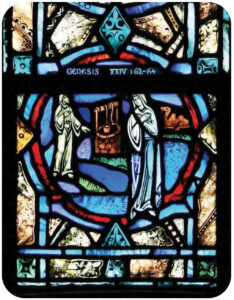 This representation isn’t intended to place Jesus’ Mother on equal footing with God but rather is an indication that without her cooperation the Incarnation couldn’t have taken place as it did. Catholic theology insists that Marian prayers (and other prayers entreating assistance from angels or saints) be offered through the Blessed Virgin Mary and not to her, and through the angels and saints and not to them. The Church is insistent that our prayers not be viewed as magical incantations and that we not begin to confuse the Blessed Virgin Mary or any of the saints with God. It’s completely permissible, however, to pray to any one of the three persons who make up the Blessed Trinity—God the Father, Jesus the Son, or the Holy Spirit.
This representation isn’t intended to place Jesus’ Mother on equal footing with God but rather is an indication that without her cooperation the Incarnation couldn’t have taken place as it did. Catholic theology insists that Marian prayers (and other prayers entreating assistance from angels or saints) be offered through the Blessed Virgin Mary and not to her, and through the angels and saints and not to them. The Church is insistent that our prayers not be viewed as magical incantations and that we not begin to confuse the Blessed Virgin Mary or any of the saints with God. It’s completely permissible, however, to pray to any one of the three persons who make up the Blessed Trinity—God the Father, Jesus the Son, or the Holy Spirit.
 ? How are both the Blessed Virgin Mary and Rebekah related to redemption and Christian hope?
? How are both the Blessed Virgin Mary and Rebekah related to redemption and Christian hope?
? In what way do you rely on the Blessed Virgin Mary to sustain the theological virtue of hope in your life?
supplemental Scripture
Not everyone is acquainted with the Old Testament parallels in Scripture & the Rosary: New Testament Mysteries, Old Testament Parallels.  While reading extra Scripture is optional, this lesson, with its focus on the Blessed Virgin Mary, is problematic. Because the Mother of Jesus is extremely important to Christianity, there aren’t many passages about her in the New Testament. There are several types of Mary seen in the Old Testament, however, most notably the Holy City of Jerusalem. Mary shows up in the New Testament book of Revelation as both the bride of Christ and as the Mother of the Church, and highly exalted as the woman clothed with the sun.
While reading extra Scripture is optional, this lesson, with its focus on the Blessed Virgin Mary, is problematic. Because the Mother of Jesus is extremely important to Christianity, there aren’t many passages about her in the New Testament. There are several types of Mary seen in the Old Testament, however, most notably the Holy City of Jerusalem. Mary shows up in the New Testament book of Revelation as both the bride of Christ and as the Mother of the Church, and highly exalted as the woman clothed with the sun.
one characteristic shared by Jesus & his Mother
We can’t fully understand why God chose this particular manner of instituting his plan for our salvation, but we can benefit from meditating about the possible reasons why he might have done so. The single most important quality shared by Jesus and his Mother is their total obedience to the will of God. Obedience, however, is a fairly misunderstood virtue in our contemporary world.
WHAT DO YOU THINK about gaining more wisdom?
It’s no coincidence that the Blessed Virgin Mary is shown seated on a throne of wisdom.
 ? How might the understanding that God’s commandments are based on love lead to an increase of goodness in the lives of men and women who are obedient in following them?
? How might the understanding that God’s commandments are based on love lead to an increase of goodness in the lives of men and women who are obedient in following them?
? Consider how wisdom and obedience might be related in your own life.
? In what ways does obedience to God play a role in your life?
? Are there any areas in which you struggle to be obedient to God or to the teachings of the Church?
? What can the Blessed Virgin Mary do to help you to gain more wisdom?
Our Lady of the Beautiful Window
The depiction of the Blessed Virgin Mary in the Redemption Window is patterned after the famous Notre Dame de la Belle Verriere (Our Lady of the Beautiful Window) in Chartres Cathedral in France. “The Throne of Wisdom” on page 17 in Scripture & the Rosary: New Testament Mysteries, Old Testament Parallels discusses the symbolism of the Mother of God as the Seat of Wisdom.
 hope—you could look it up in our archives
hope—you could look it up in our archives
Hope is perhaps the least understood of the three theological virtues. (The other two are faith and love.) To learn about the link between “hope” and expectation, read Lost in Translation, an online column in which Turning to God’s Word author Matthew Phelps helps readers connect with ideas expressed in the original languages of the  Scriptures. New Lost in Translation entries are posted on Mondays, and past entries are archived on our website. Contact us if you’d like to receive Lost in Translation by email every week. You can learn more about hope in Lesson 8 A Better Hope Is Introduced in the Turning to God’s Word Catholic Bible study The Letter to the Hebrews: An Explanation of the Mechanism of Our Salvation.
Scriptures. New Lost in Translation entries are posted on Mondays, and past entries are archived on our website. Contact us if you’d like to receive Lost in Translation by email every week. You can learn more about hope in Lesson 8 A Better Hope Is Introduced in the Turning to God’s Word Catholic Bible study The Letter to the Hebrews: An Explanation of the Mechanism of Our Salvation.
 the best Catholic commentary about Scripture
the best Catholic commentary about Scripture
To find out more about how Church teaching is supported by passages in Scripture & the Rosary: New Testament Mysteries, Old Testament Parallels, check out the Index of Citations in the Catechism of the Catholic Church. Links (Revised Standard Version Catholic Edition [RSVCE*]) to the primary Scripture passages in the lesson and relevant paragraphs in the Catechism are provided here. Not every passage in the biblical text for this study is referenced in a Catechism paragraph, however, including the passages in this lesson from the book of Genesis 24:58–60 and the book of Genesis 24:62–67.
the Letter to the Hebrews 6:13—paragraph 2810
the Letter to the Hebrews 6:19–20—paragraph 1820
to learn more, read more Scripture
When you’re having difficulty understanding a passage of Scripture, it can help to read the  cross references—but looking these up takes time. We’ve compiled the cross references from the Revised Standard Version Second Catholic Edition (RSV2CE)—the same translation that we reprint in our study books. The list can be found at the top of every supplemental study page in this study, and it includes links to cross references in the primary biblical texts for all of the lessons in Scripture & the Rosary: New Testament Mysteries, Old Testament Parallels.
cross references—but looking these up takes time. We’ve compiled the cross references from the Revised Standard Version Second Catholic Edition (RSV2CE)—the same translation that we reprint in our study books. The list can be found at the top of every supplemental study page in this study, and it includes links to cross references in the primary biblical texts for all of the lessons in Scripture & the Rosary: New Testament Mysteries, Old Testament Parallels.
don’t forget about our indexes & extra online material

 If you’re trying to locate information about a Scripture passage, you can look it up in the index at the back of the online version of this study. If you want to revisit a commentary, you can look it up by title in the topics index. If you want to learn more about another book of the Bible for which there’s a Turning to God’s Word study, you can read online commentaries and watch any accompanying videos by choosing a lesson from one of the study directories. (There are no lesson videos with Scripture & the Rosary: New Testament Mysteries, Old Testament Parallels.) Finally, if you have a question or would like to make a comment about any of our studies, you can use the “ask us your question” or “what do you think” button to email our authors.
If you’re trying to locate information about a Scripture passage, you can look it up in the index at the back of the online version of this study. If you want to revisit a commentary, you can look it up by title in the topics index. If you want to learn more about another book of the Bible for which there’s a Turning to God’s Word study, you can read online commentaries and watch any accompanying videos by choosing a lesson from one of the study directories. (There are no lesson videos with Scripture & the Rosary: New Testament Mysteries, Old Testament Parallels.) Finally, if you have a question or would like to make a comment about any of our studies, you can use the “ask us your question” or “what do you think” button to email our authors.
ex libris—Church documents & books about religious topics
Link to magisterial documents referred to in our Bible studies at ex libris—magisterial documents.  This listing includes significant recent encyclicals as well as a number of historical Church documents. Recommended books related to Scripture study can be found at ex libris—main bookshelf.
This listing includes significant recent encyclicals as well as a number of historical Church documents. Recommended books related to Scripture study can be found at ex libris—main bookshelf.
wondering how to pronounce some of these words?
The following links are to readings from the New International Version (NIV) Bible. To listen, click on the audio icon above the printed text. Although not taken from the translations used in our study materials, the NIV readings provide an audio guide to pronunciation of words in this lesson’s primary biblical texts. A close online version of the translation of the Bible used in Catholic liturgy in the United States as well as an audio guide for daily Mass readings for the current month can be found on the website of the United States Conference of Catholic Bishops (USCCB).
the Letter to the Hebrews 6:13–20 (NIV)
the book of Genesis 24:58–60 (NIV)
the book of Genesis 24:62–67 (NIV)
pray the Rosary
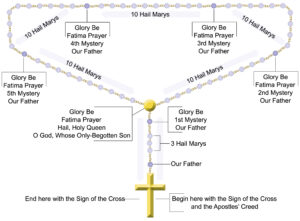 We invite you to pray the Rosary along with Turning to God’s
We invite you to pray the Rosary along with Turning to God’s  Word co-founder Tami Palladino and her daughter Anne Marie. Their videos are available on the online study pages for Lessons 7 through 26, and the Rosary prayers as well as the videos for all 20 mysteries are accessible year-round at how to pray the Rosary. Clicking on the diagram (right) will take you to the website page with the Rosary prayers. Watch Tami and Anne Marie’s how-to video (below) to learn more about praying the Rosary.
Word co-founder Tami Palladino and her daughter Anne Marie. Their videos are available on the online study pages for Lessons 7 through 26, and the Rosary prayers as well as the videos for all 20 mysteries are accessible year-round at how to pray the Rosary. Clicking on the diagram (right) will take you to the website page with the Rosary prayers. Watch Tami and Anne Marie’s how-to video (below) to learn more about praying the Rosary.
Lesson 6 The Holy Spirit: Sanctification & Love—the First Letter to the Corinthians 13:1–10, the First Letter to the Corinthians 13:12–13, and the book of Genesis 46:26–30
Lesson 4 God the Father: Creation & Faith—the book of Genesis 1:26–31, the book of Genesis 18:2–5, and the book of Genesis 18:8–10
you also may like our study of Saul, David & Solomon
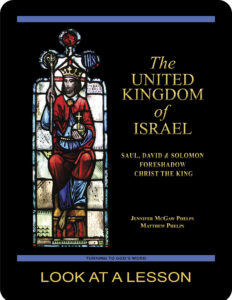 The United Kingdom of Israel: Saul, David & Solomon Foreshadow Christ the King, a 28-lesson Catholic Bible study with an imprimatur, provides an in-depth look at the First and Second Books of Samuel to learn how the lives of the monarchs Saul, David, and Solomon point ahead to the kingdom of heaven. The unified reign of King David is seen as a foreshadowing or type of the unity that is one of the four marks of the Church—the kingdom of God—established by Jesus Christ. Click on the book’s cover to view a sample lesson.
The United Kingdom of Israel: Saul, David & Solomon Foreshadow Christ the King, a 28-lesson Catholic Bible study with an imprimatur, provides an in-depth look at the First and Second Books of Samuel to learn how the lives of the monarchs Saul, David, and Solomon point ahead to the kingdom of heaven. The unified reign of King David is seen as a foreshadowing or type of the unity that is one of the four marks of the Church—the kingdom of God—established by Jesus Christ. Click on the book’s cover to view a sample lesson.
start a Turning to God’s Word Bible study
 Thank you for your interest in Scripture & the Rosary: New Testament Mysteries, Old Testament Parallels.
Thank you for your interest in Scripture & the Rosary: New Testament Mysteries, Old Testament Parallels.  Information about beginning a Turning to God’s Word Bible study can be found at start a Bible study. Tami, Matthew, and I are available to answer your questions and to offer support. You may use this email to contact us directly if you’re interested in starting a Turning to God study or in having your study schedule listed with other TtGW study groups on our website. —Jennifer
Information about beginning a Turning to God’s Word Bible study can be found at start a Bible study. Tami, Matthew, and I are available to answer your questions and to offer support. You may use this email to contact us directly if you’re interested in starting a Turning to God study or in having your study schedule listed with other TtGW study groups on our website. —Jennifer
*There are seven deuterocanonical books in the Old Testament—the Books of Tobit, Judith, Wisdom, Sirach, Baruch, and First and Second Maccabees, as well as some passages in the Books of Esther and Daniel. Protestants usually refer to these works as “apocryphal,” a word that means “outside the (Protestant) canon” because they’re excluded from most Protestant Bibles. The word “deuterocanonical” means “second canon”; Catholics use that word to refer to any section of the Catholic Old Testament for which there are no extant, or existing, Hebrew manuscripts. All of the deuterocanonical books appear in the Septuagint, the earliest remaining versions of which date to the 1st century B.C. This Greek translation of the Old Testament was in common use by Jews at the time of Jesus—but the same books aren’t found in existing Hebrew manuscripts, which aren’t as old as the oldest version of the Septuagint. Learn more by reading How Do Catholic & Protestant Bibles Differ?
Turning to God’s Word printed Bible studies use the 2006 Revised Standard Version Second Catholic Edition (RSV2CE) translation for all Scripture references except those to the Psalms, which are taken from The Abbey Psalms and Canticles, prepared by the Benedictine monks of Conception Abbey and published in 2020 by the United States Conference of Catholic Bishops (USCCB). All Scripture links for the digital version of Scripture & the Rosary: New Testament Mysteries, Old Testament Parallels are to the 1966 Revised Standard Version Catholic Edition (RSVCE) translation. The New International Version (NIV) audio recordings follow the same chapter and verse numbering as the RSV Catholic translations, but the NIV translation doesn’t include the deuterocanonical books and passages.
The 1966 RSVCE uses archaic pronouns and verb forms such as “thee,” “thou,” “didst” in the Psalms and in direct quotations attributed to God. The 2006 RSV2CE replaces those with more accessible English. The few significant translation changes in the RSV2CE include rendering almah as “virgin” in the Book of Isaiah 7:14 and restoring the term “begotten” in the Gospel According to John 3:16.
Numbering varies for some passages in this Bible study. Turning to God’s Word studies follow the numbering in the Revised Standard Version Catholic translations (RSV2CE and RSVCE). Discrepancies in the New American Bible Revised Edition (NABRE) are noted in the Index of Scripture Citations.
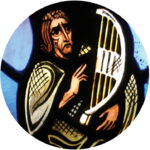 You can learn more about the Psalms by viewing a sample lesson from the Turning to God’s Word Catholic Bible study Sing a New Psalm: Communicating with God Through the Prayers of the Church—Volume I: Lauds & Vespers. The second part of that study, Sing a New Psalm: Communicating with God Through the Prayers of the Church—Volume II: Vigils, Day Prayer & Compline, is scheduled for publication in 2025. Some verse numbers may vary in different translations of the Psalms.
You can learn more about the Psalms by viewing a sample lesson from the Turning to God’s Word Catholic Bible study Sing a New Psalm: Communicating with God Through the Prayers of the Church—Volume I: Lauds & Vespers. The second part of that study, Sing a New Psalm: Communicating with God Through the Prayers of the Church—Volume II: Vigils, Day Prayer & Compline, is scheduled for publication in 2025. Some verse numbers may vary in different translations of the Psalms.
